I reviewed Vorke Z3 Android mini PC last month, the first mini PC I’ve received with a USB type C port capable of handling video output too. I could see support for dual HDMI displays in the firmware, but at the time I did not have a USB type C hub with HDMI output. But Dodocool sent me their DC30C USB type C hub so I’ve finally been able to give a try.
Dodocool DC30S Specifications
- USB Input – 13 cm USB 3.1 Type-C cable
- USB Outputs – 3x USB 3.0 type A ports up to 5 Gbps; 1x USB 3.1 Type-C PD charging port
- Video Output – HDMI port
- Storage – SD & Micro SD card reader
Dodocool DC30S Unboxing
First the package which gives basic info about the USB hub.
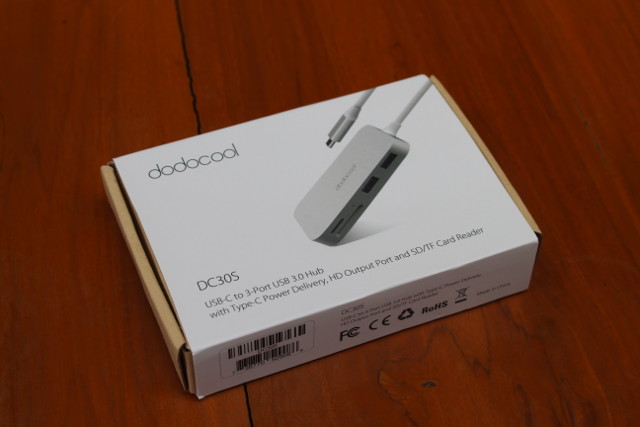 The device comes with a warranty registration card, and a multi-language user manual.
The device comes with a warranty registration card, and a multi-language user manual.
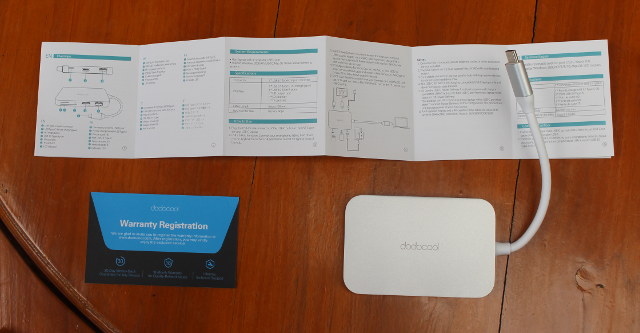
One side comes with the SD and micro SD card slots with LED indicator, and two USB 3.0 ports…
 … while the other side includes a USB Type C female charging port, HDMI output, and another USB 3.0 port.
… while the other side includes a USB Type C female charging port, HDMI output, and another USB 3.0 port.
Using Vorke Z3 USB Type C port with Dodocool DC30S USB Hub
I found a two USB flash drives, and a SD card that I connected to the USB hub, as well as an HDMI cable connect to a Full HD TV, and my phone’s charger.
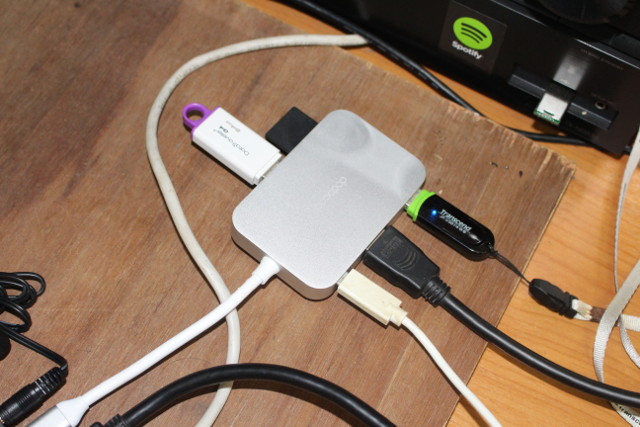 I connected the USB Hub to Vorke Z3 mini PC, and extra cables to another 4K TV, and Ethernet switch, as well as a dongle for my air mouse.
I connected the USB Hub to Vorke Z3 mini PC, and extra cables to another 4K TV, and Ethernet switch, as well as a dongle for my air mouse.
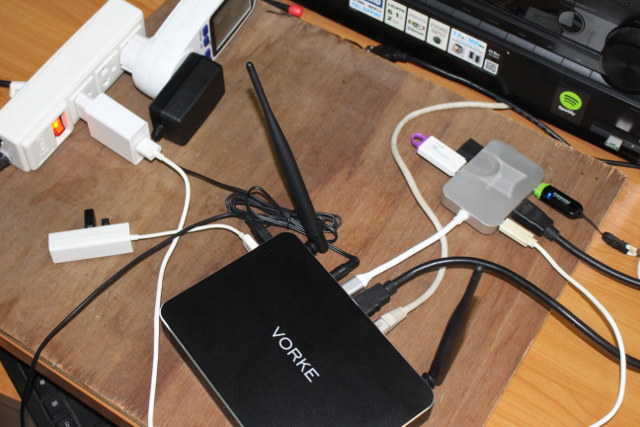
At first I did not connect the USB type C charger, and the storage devices would not show, and while my Full HD TV would detect something was connected via HDMI, it would show “No Signal”. I tried to connect the HDMI cable from the USB hub to the 4K TV, and I had the same problem. So I connected the USB power supply, and I could see the power draw from Vorke Z3 drop by about 2 Watts, but I would still not be able to use anything connected to the USB hub. Later I tried to disconnect and reconnect the USB hub, and magically everything worked (almost) as expected. It looks like disconnecting the USB type C port supply and reconnecting it may have an effect too.
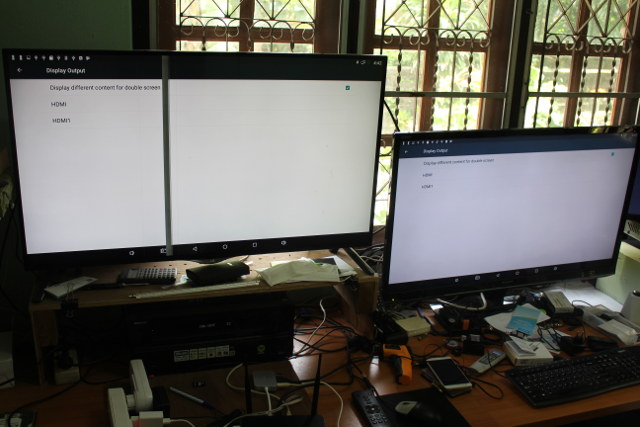
We have the 4K TV on the left connected directly via Vorke Z3’s HDMI port, and the Full HD TV on the right connected via the USB type C port through DC30S’s HDMI port. The option “Display different content for double screen” did not work for me, so I could just use it to mirror the display, but that’s related to Vorke Z3’s firmware, not Dodocool’s USB hub.
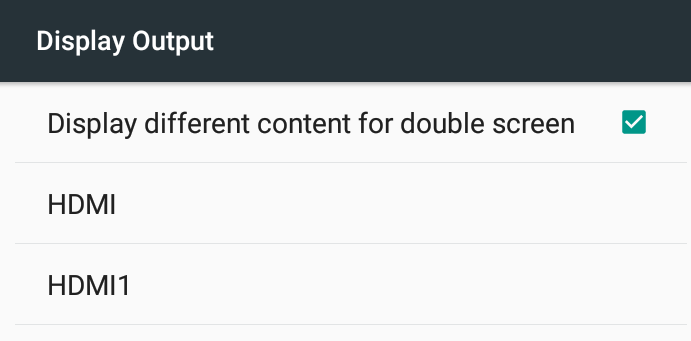 HDMI1 is the output for the USB type C port, and I set it to 1920×1080 @ 60 Hz. That’s the maximum resolution via Vorke Z3’s USB type C port according to GeekBuying.
HDMI1 is the output for the USB type C port, and I set it to 1920×1080 @ 60 Hz. That’s the maximum resolution via Vorke Z3’s USB type C port according to GeekBuying.
Storage also worked fine, but all USB flash drive were boot drives, and not recognized the TV box, I had another random USB flash drive, and I could mount and navigate LIBREELEC partition, as well as copy files to it.
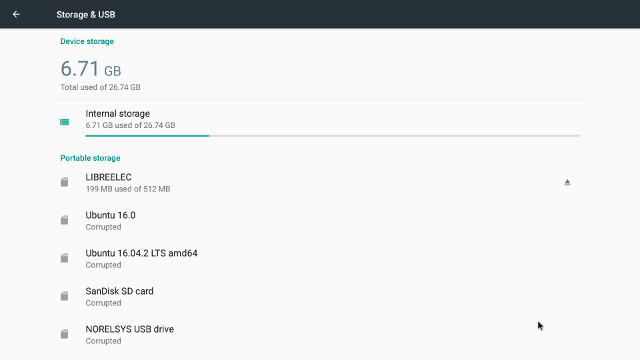 A final test was to connect my USB 3.0 drive, and first I would get no storage shown at all. I disconnected the power supply, and suddenly it was detected, and got mounted, but there seemed to be power issues with the HDMI port of the USB type C shown on and off in my TV. I reconnected the USB power adapter, and got everything to work again. I ran A1SD bench to check whether I could still get the same 90 MB/s read/write speeds I got when the hardware was directly connected to the USB 3.0 port of the mini PC, and that was the case. I don’t have hardware to test the 5 Gbps bandwidth.
A final test was to connect my USB 3.0 drive, and first I would get no storage shown at all. I disconnected the power supply, and suddenly it was detected, and got mounted, but there seemed to be power issues with the HDMI port of the USB type C shown on and off in my TV. I reconnected the USB power adapter, and got everything to work again. I ran A1SD bench to check whether I could still get the same 90 MB/s read/write speeds I got when the hardware was directly connected to the USB 3.0 port of the mini PC, and that was the case. I don’t have hardware to test the 5 Gbps bandwidth.
I’d like to thank Dodocool for sending a review sample, and if you are interested, you can purchase DC30S USB type C Hub on Amazon US for $26.99. You may also want to check the product page.

Jean-Luc started CNX Software in 2010 as a part-time endeavor, before quitting his job as a software engineering manager, and starting to write daily news, and reviews full time later in 2011.
Support CNX Software! Donate via cryptocurrencies, become a Patron on Patreon, or purchase goods on Amazon or Aliexpress






I’ve ordered one of their other models recently, no SD card reader but gigabit ethernet instead. It’s a shame about the 1080p 60Hz limit. I thought it was going to be capable of 2560×1440 60Hz.
@CampGareth
The limit may be because of Vorke Z3, not the USB hub itself. I don’t know for sure, since I don’t have any other devices to check.
Do you have to install a driver for your cable now ? To have video out
@agumonkey
No driver needed, it’s just play and play.
I think the USB hub must be using DisplayPort Alternate mode for USB Type-C, since AFAIK HDMI alt mode is not commercialized yet, so the hub should be converting DisplayPort to HDMI.
So many cables, they drive me mad.
I don’t care what it costs and whether it works or not. With a name like “Dodocool” I MUST own one!
Geekbuying confirmed dual independent displays are not supported in Vorke Z3, despite the option in the settings. So USB type C video output can only be used for mirroring.
@cnxsoft
That’s promising then. When mine arrives I’ll try it out with a GPD Win and Dell XPS 13, then try to return here to report. I’d only expect HDMI 1.4 out of it but that means 3840×2160 @ 30Hz or 2560×1440 @ 60Hz.
@CampGareth
4K support will depend on the model. I can see their DC50 model supports 4K video output. It also comes with Ethernet. Is that the model you bought?
@cnxsoft
Looks like I ended up with the DC35 which does use the DP alternate mode, supports 4K on the HDMI port. The main difference between it and the DC50 is a VGA output which I won’t be using day to day but could be useful for whenever I visit the 1990s 😛
@cnxsoft
Reporting in. My DC35 turned up and so far it’s been a mixed bag. Yes it can drive a 2560×1440 display at 60Hz off the HDMI port so that’s good. On the realtek ethernet I’m seeing 700mbit up 900mbit down with iperf to my pfsense router, the down speeds are what I’d expect running through as many hops as that test was but I’m not sure about the up speeds. Could be a CPU limitation on an i5-6200U.
USB-PD passthrough works with the XPS 13, but power is an interesting issue. My XPS 13 can power the DC35 with HDMI and ethernet attached even while running off battery power so it’s a good device for taking to conferences and whatnot. My GPD Win had no such luck. When plugging in the Win I heard the windows device connected/disconnected noises in rapid succession and the sound of power circuitry in pain. The LED on the DC35 was flashing all the while. I’d be curious to know what the power consumption is but the Win has problems with power anyway so it wouldn’t take much to cause problems. When I plugged external power into the DC35 then connected it to the Win, the Win refused to charge off it for some reason. It also wouldn’t detect that a device had been attached. Confusing behaviour.